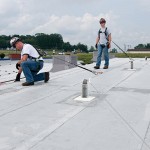Why do fall protection systems as they apply to safety harnesses vary greatly in the cost of materials?
 Starting with harnesses, a big driver of the cost of the equipment is ensuring comfort of the worker, so the material used is very important. For example, if you wear a harness all day, moving to lightweight aluminum hardware with a padded/cushioned harness will result is less wear on the body, resulting in more comfort. Equally as important to comfort is safety.
Starting with harnesses, a big driver of the cost of the equipment is ensuring comfort of the worker, so the material used is very important. For example, if you wear a harness all day, moving to lightweight aluminum hardware with a padded/cushioned harness will result is less wear on the body, resulting in more comfort. Equally as important to comfort is safety.
Lanyards for a welder will be inherently more expensive due to the nature of a welder’s job, which involves sparks and fire, and the cost of materials to ensure protection. A welder should only be using a lanyard made of synthetic material or a steel cable with an embedded shock pack to ensure it is flame resistant. Sparks and fire will cause damage to non-fire-resistant-treated lanyards, thus, potentially causing failure.
Like harnesses, all fall protection systems have varying degrees of cost. The easiest and most straightforward explanation of this would be horizontal or vertical cable versus fixed tack lifelines. From a material cost perspective, cable lifelines are inherently much less expensive, especially over very long distances. The main component of the lifeline is readily available galvanized aircraft cable and in-line shock absorbers. However, due to the elastic nature of aircraft cable, this solution will not work in places with short fall clearances. If a short fall clearance is the primary issue, fixed rigid track lifelines must be used. This will increase your cost due to how much steel goes into these tracks, particularly over longer distances.
View All FAQs.

